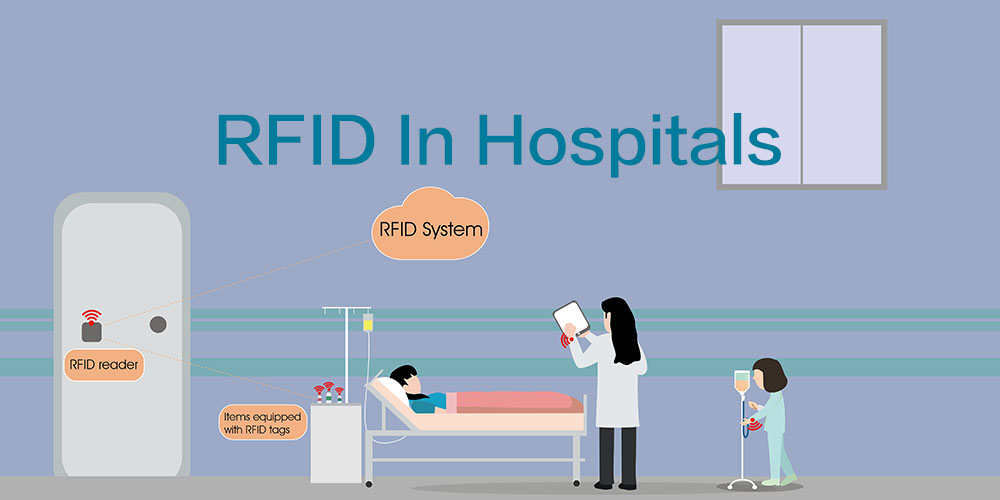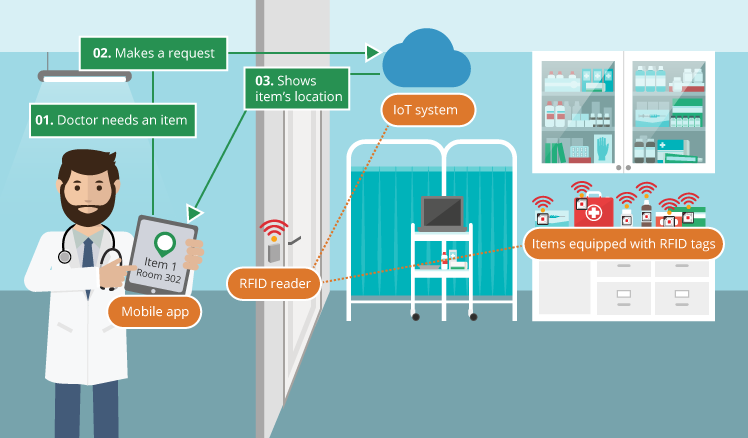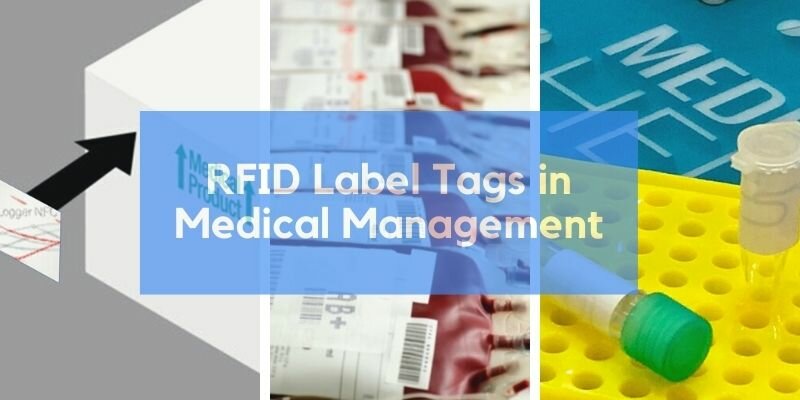RFID for Healthcare: What RFID Hospital Management offers?
In recent times, increasing efficiency with radio frequency identification (RFID) technology has become popular in the health sector, as we aspire to increase efficiency with smart solutions. RFID technology makes it possible to identify, track, and locate items in real-time data through radio frequency signals.
Considering that hospital expenses of lost or missed medical supplies, tools, and equipment, RFID in health is now widely used in the health care industry.
Let’s now look at how RFID in health is used in different applications on basis of patient management, equipment management and inventory management.
Tracking of Patients
Smart patient tracking is an excellent example of how RFID and IoT can facilitate better healthcare services and, as a result, drive better care in the healthcare environment.
Using RFID patient wristbands to track patients in hospitals improves security, identifies and addresses gaps in internal processes, improves bed allocation, updates doctors’ schedules, and improves patient satisfaction.
Patient records on wristbands are commonly maintained and verified using passive RFID systems. These details are saved on the tag’s chip or linked to the tag’s ID through a recording database within these systems.
Do you ask how so?
Let’s try to imagine it together:
- You arrived at the hospital and were given an RFID wristband immediately.
- Each of these tags will store your personal information such as your name, ID no, medical record, allergies, current situation, test results, prescription, appointment dates.
- As you move within the hospital, readers mounted on the walls and along the halls will read your RFID patient wristband’s chip and continue receiving and transmitting your information.
- So, hospital staff and doctors can monitor where you are or possibly do in real-time.
- Indeed, they do not need to talk to you to get recent updates of your status, and they can scan your RFID wristband even if you are resting or sleeping.
- The same applies to locating critical hospital staff and doctors within the hospital and calling them in emergency cases more easily.
Goodwin RFID Disposable Wristband for Patient can be customized in different colors and with logo prints along with your corporate identity and ease the patient management and hospital administration at one go.
Management of Hospital/Medical Equipment
The disadvantages and limits of manual asset tracking, such as slow pace, human errors, and a lot of paperwork, can be eliminated by automation. And this automation can be implemented through RFID tags.
1. Increased drug supply: When a hospital’s supply of a certain medication is running low, an RFID-based inventory system can immediately order a fresh batch.
2. Automated medical equipment usage reports: weekly, monthly, and on-demand information on how different departments use hospital items to discover missing or underutilized assets.
- Tracking: You can track and locate medical utensils and large equipment between rooms, patient rooms or emergency rooms.
Goodwin’s RFID tags for medical devices are PCB metal tags that come in various sizes (from small sizes to large equipment sizes) to meet the needs of various objects.
For example, it is possible to apply adhesive to a small surgical tool or install it on larger metal medical equipment. In addition, RFID medical tags provide real-time transparency, identification, and exact location of medical devices and equipment.
Using RFID medical tags to track small or large equipment, how it works?
These RFID medical device tags range from 5mm (5x3mm) to 18x8mm (18x8mm). And, depending on the tag size and reader used, the reading range varies from 0 to 10 meters. And what it means for application is that you can use these RFID tags for small or larger equipment in nearby or more spacious areas, including operating rooms, emergency rooms and hospital zones.
Track, sterilize, reuse
Between medical equipment usage, surgical instruments and other equipment must be disinfected and packaged properly. RFID medical tags and readers in sterilization compartments and storage spaces can verify cleansing and assist in the location of needed instruments. In this way, you can optimize complete equipment management and maintenance besides tracking.
Hospital RFID Inventory Management
For more effective labeling of difficult materials and products, on-metal latest technology RFID tags have been utilized in different sectors, and one of them is healthcare. The system can work with liquid-filled containers, and liquid-filled metal packaging, among other things.
The application areas of these Hospital Inventory Management Medical RFID Tag are:
- Accurate labeling and identification of laboratory vials
- Collecting and archiving data of blood units, bags, body fluid samples accurately
- Tracking of lab results
- Tracking and keeping records of medicines within the hospital or specific rooms in real-time
- Minimizing the time spent on organizing lab vials
- Transporting critical blood/liquid samples with maximum accuracy of personal details
Why is RFID for medicine outperforming other technologies?
- RFID tags outperform barcodes in terms of security as they are difficult to copy or duplicate.
- It becomes possible to have accurate and up-to-date inventory information as well as the capabilities to count quickly.
- The critical equipment and appliances will be protected from unauthorized usage or misplacement.
- By reducing human-made errors, the administration of the hospital becomes smoother, and the patient experience improves.
Best Practices of RFID in Health
Guntur General Hospital uses a synchronized Radio Frequency Identification (RFID) Tags on the mother and newborn as a safety precaution, a first for any public sector hospital in India.
Whenever the baby is relocated beyond the specified access points, the units with the ‘antenna and transceiver’ placed there will read the microchip in the RFID tag and sound an alarm. Hence, mislocation or loss of newborns will be eliminated to a maximum extent.
The Royal Children’s Hospital enhances its patient experience and safety through improving barcode-based scanning systems for fluids such as blood. In turn, they had increased accuracy and patient safety and increased speed when scanning information up to 50%.
One of the best heart care hospitals, Saint Luke’s Health System in Kansas City, Missouri, deemed necessary a next-generation inventory tracking and management system to keep providing the best care possible. As a result, Saint Luke’s implemented an RFID-based inventory management system with RFID tags, readers, mobile computers, and inventory software that is completely integrated.




